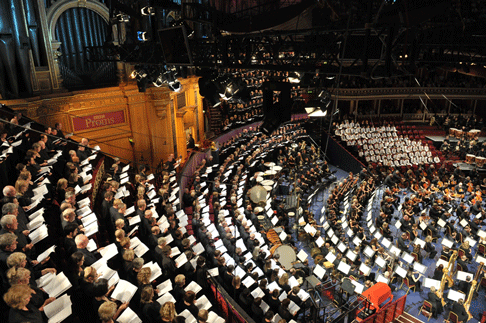19 Jul 2011
Havergal Brian’s “Gothic” Symphony
The BBC Proms has given Havergal Brian’s Symphony no. 1 the best and most extensive exposure the composer has ever enjoyed.

The BBC Proms has given Havergal Brian’s Symphony no. 1 the best and most extensive exposure the composer has ever enjoyed.
Havergal Brian (1876-1972) is a cult figure in British music who attracts an intense following, even though his music is rarely performed and existing recordings are of not of the highest standards. He’s better known by reputation than by listening experience. Indeed, it’s this very air of exclusivity that’s part of his appeal. BBC Prom 4 was a historic watershed in Brian reception, because it gave Brian maximum possible publicity, and the best performance to date.
This was a truly spectacular, extravagant event. Brian’s “Gothic” Symphony is apparently in the Guinness Book of Records for being the biggest symphony ever written, and only the BBC Proms can provide the resources to do it justice. Thus, this Prom was a once-in-a-lifetime experience, a historic occasion that wasn’t to be missed. It was a form of total theatre that will be remembered for decades.
One third of the massive Royal Albert Hall was reserved to accommodate the sheer number of performers, almost a thousand in all. Nine choruses, no less, visually impressive, especially the women’s choir in lavender, and the children’s choirs in white. Two main orchestras, the BBC National Orchestra of Wales and the BBC Concert Orchestra. Two “timpani orchestras”, as opposed to “symphony orchestras”, positioned at the sides of the auditorium, between the choristers and audience. Those sitting near them may be deaf for days. And, like a Colossus above them all, the mighty Royal Albert Hall Willis organ, with its 9,997 pipes and 149 stops, the largest in Europe.
Martyn Brabbins conducted the gargantuan forces with aplomb. He’s braved the dense jungle of this score like a fearless explorer mapping unknown territory. He’s clearly prepared the work thoroughly, searching out the main features in this bewildering terrain. Brian’s “Gothic” is a strange Leviathan which has defeated the best efforts of many, so Brabbins deserves a medal for persistence and dedication.
Brabbins focuses on the many details which build up to form the dense undergrowth. A flurry of harps, for example, and a bizarre chorus of xylophones, springing out unexpectedly, like exotic birds startled into flight. The whole symphony seems to be built from details like this, an accumulation whose object is to amass as many pieces as possible — not a jigsaw, for the ideas don’t really cohere. So Brabbins’s carefully thought out detail brings out the endless proliferation that gives this symphony its charm.
Brian was a self-taught, almost eccentric character who wasn’t particularly bothered by the practicalities of performance. There are many ideas in this symphony, but they are briefly glimpsed and don’t develop. On paper, they may look good, but they don’t necessarily make much sense in practical performance. For example, the timpani orchestras, backed by very loud brass. At first they call out to each other across the expanse of the auditorium. Then one falls more or less silent thereafter.
Brian’s Gothic has been compared to Mahler’s Eighth Symphony, on the basis that the latter was marketed as the “symphony of a thousand”, but the comparison is nonsense. The label was a PR ruse. Mahler’s focus was on spiritual meaning. Although Mahler’s structure is unorthodox, there’s a powerful trajectory that pulls it forward. The inspiration behind Brian’s symphony isn’t consistent. Liturgical texts are used, but the thrust isn’t particularly spiritual. Brian is certainly ambitious, quoting Goethe’s Faust on his title page, (“Whoever strives with all his might, that man we can redeem”), but the energy dissipates.

For example, in the final movement, the ‘Te ergo quaesumus’, Alastair Miles intones lines that waver upwards and down, perhaps in homage to Orthodox chant, but the orchestra then plays a parody of jazz swing. Sometimes contrasts have reason, but in this symphony they seem to exist for variety’s sake. When Susan Gritton sings ‘Judex crederis esse venturus’ from way up in the rafters, it’s a truly sublime moment — magnificent singing, magnificently theatrical. But the rest of the movement consists of that 4-word sentence alone, and it’s quickly dispensed with in favour of meaningless extended vocalise. In all three major Proms concerts so far (Janáček’s Glagolitic Mass and Rossini’s William Tell) the tenor parts have been fiendishly difficult. Peter Auty deserves recognition for valour, since he surmounted Brian’s extreme demands for his part. Christine Rice sang part well, but Brian leaves the part curiously underwritten.
This performance of Brian’s “Gothic” symphony was hugely enjoyable because it worked remarkably well as theatre. Brian himself may not have anticipated the concept of sonic architecture quite in the way that others — including Stockhausen, whom Brabbins also conducts well — but the BBC Proms and the Royal Albert Hall can work wonders. Brabbins and his multitude deserve a great deal of credit, but so too, do the organizers who made this possible in the first place — a thousand performers and a huge array of instruments. Moving this army must have been a logistic nightmare. Many of these choirs are major names on the choral scene, and were brought in from all over the country.
Hopefully, Brabbins’s Proms performance of Brian’s “Gothic” will be recorded, if only to recoup the enormous costs. It’s a superlative way into the symphony particularly as so little of this music is available. Fortunately, the Havergal Brian Society website is so comprehensive that now everyone can become familiar with his work even if they haven’t heard it.
Every single concert in the BBC Proms 2011 series is broadcast live online and on demand for several days, complete with facsimile programmed notes. For more details, please visit the BBC Proms website.
Anne Ozorio